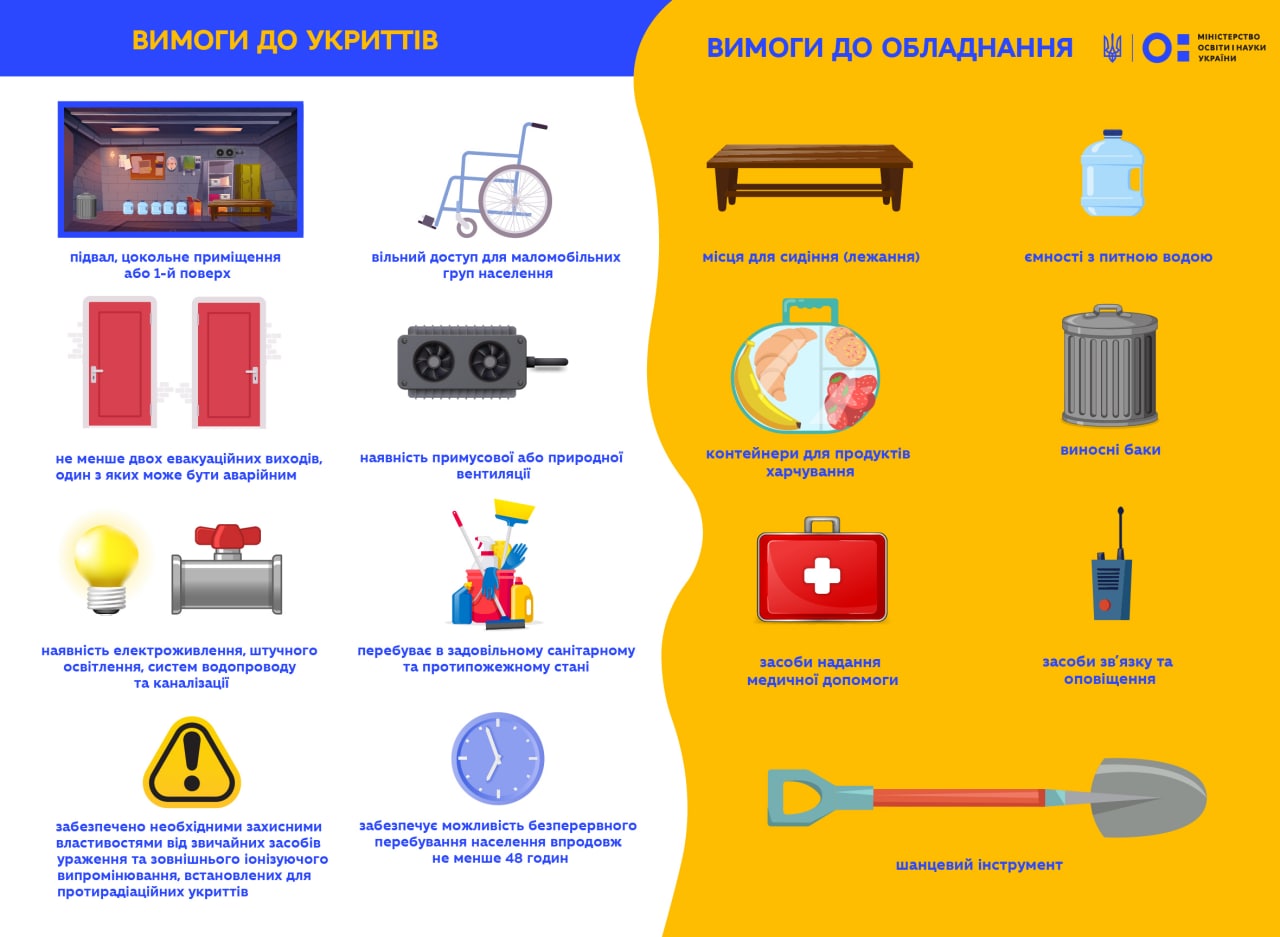The State Emergency Service has developed recommendations for the organization of shelters in the objects of the fund of protective edifices of civil protection of personnel and children (pupils, students) of educational institutions.
Shelters must meet the following requirements:
- to be located in a basement (underground) room, on the basement or on the first floor (provided that it is subject to provision of enclosing building structures);
- to be located in the main building of the educational institution or in the immediate vicinity (up to 100 m);
- not to be located near large tanks containing dangerous chemical, flammable, combustible and explosive substances, water supply and sewage mains;
- should not be negatively affected by soil, surface, process or waste water;
- to be provided with electricity, artificial lighting, water supply and sewage systems. In the absence of water supply and sewage in the construction sites, they should contain separate rooms for installing portable tanks;
- do not have large openings in the external enclosing structures, existing openings (except for doors) provide the possibility of laying (bags with sand or soil, concrete blocks, brickwork, etc.);
- to be provided with at least two evacuation exits, one of which can be an emergency exit (in the case of planning a shelter in a dual-purpose edifice or the simplest shelter with a capacity of less than 50 people, one evacuation exit is allowed);
- water and sewage mains, other main engineering communications (with the exception of intra-house engineering networks) should not pass through the shelter. The premises have a flat floor suitable for seating and lying;
- inflammable, chemical and radiation hazardous substances, dangerous equipment that cannot be dismantled or cannot be dismantled within 24 hours are not stored in the premises;
- the height of the premises of the objects, in particular the doorways, is at least 2 m (at least 1.8 m is allowed, if it is provided for in the project documentation), and to the protruding parts of individual building edifices and engineering communications (with the exception of doorways) – at least 1.4 m. The width of the door openings is not less than 0.9 m (not less than 0.8 m is allowed, if it is provided for in the project documentation). Crossing of doorways by building structures or engineering communications is not allowed;
- openings at the entrances (exits) should be closed with reinforced doors made of non-combustible materials (metal or wooden, lined with iron) or protective screens (stone, brick, reinforced concrete) to a height of at least 1.7 m;
- the main premises intended for sheltering the population should have forced or natural ventilation;
- free access of people with reduced mobility must be ensured (for educational institutions with the presence of the specified category of persons) or there is a technical possibility of retrofitting within 24 hours;
- the object must be in a satisfactory sanitary and fireproof condition (in accordance with the norms of fireproofing and sanitary rules);
- must be provided with the necessary protective properties for protection against conventional means of damage and external ionizing radiation installed for anti-radiation shelters (dual-purpose structures with appropriate protective properties).
The necessary protective properties are provided by objects with walls 2-2.5 bricks thick, or from one-piece reinforced concrete edifices (blocks, panels) with a thickness of 56 cm or more. Appropriate protective properties are also provided by a layer of soil 67-78 cm thick (a bag with sand laid across the edifice). If the building edifices have a smaller thickness, it is possible to increase the protective properties by additional coating with bags of soil or sand, installation of screens made of reinforced concrete structures (panels, blocks, etc.).
Shelter equipment is designed for a continuous stay of at least 48 hours, so it is necessary to ensure:
- places for sitting (lying). One can use the chairs, benches or beds, sports mats, and tourist voucher available in the institutions;
- containers with drinking water (one person/2 liters per day);
- food containers;
- portable sewage tanks that close tightly (for nonsewered buildings and structures);
- backup artificial lighting (electric lanterns, candles, kerosene lamps, etc.) and power supply;
- primary means of extinguishing fire (in accordance with established standards);
- means of providing medical assistance;
- means of communication and notification (telephone, radio, Internet, installation of Wi-Fi devices is recommended);
- chance tools (bayonet and scoop shovels, crowbars, axes, saws, hacksaws, etc.).
In addition, one of the requirements is compliance with the rule of at least one meter per person.
If possible, the simplest shelters are provided with additional equipment, tools and inventory in accordance with the norms established for protective structures.
A 50x60 cm sign must be placed near the entrance door with the inscription “SHELTER PLACE”, as well as the address of the location of the building, its balance holder and key storage location.
It should be recalled that the government has approved the volumes of the state order for training in institutions of advanced professional education in 2022, and access to international databases has been extended for Ukrainian scientists.
Media Center of
National University “Yuri Kondratyuk Poltava Polytechnic”



